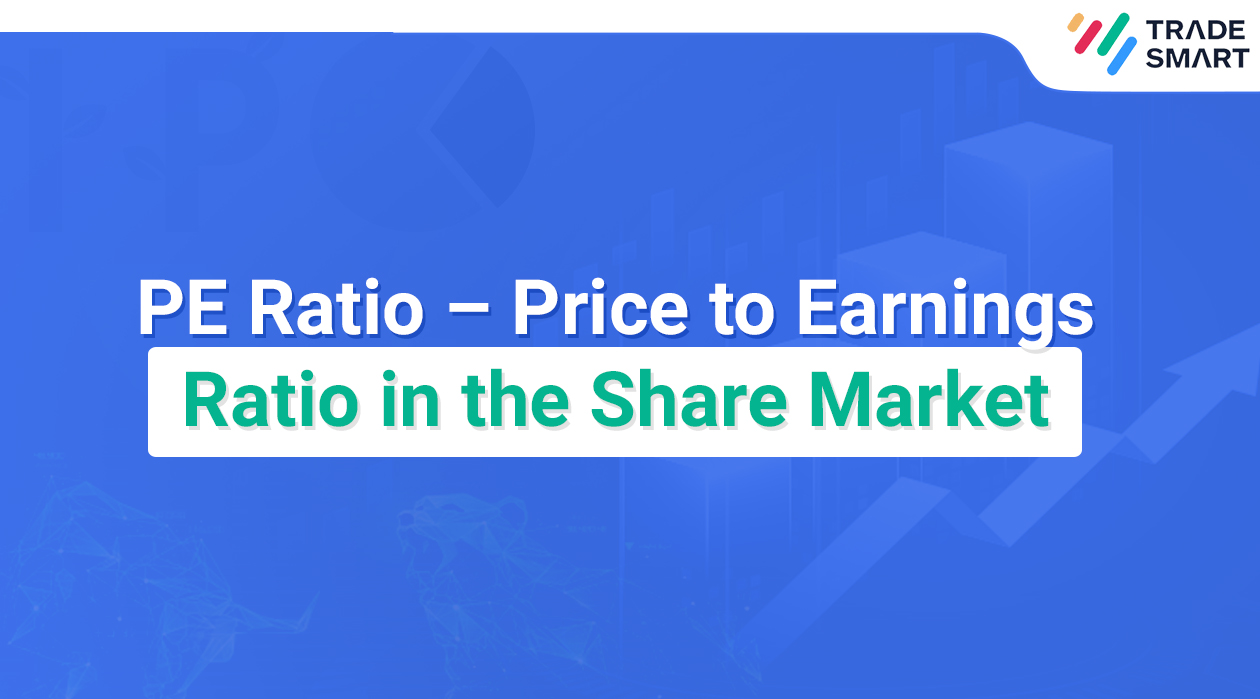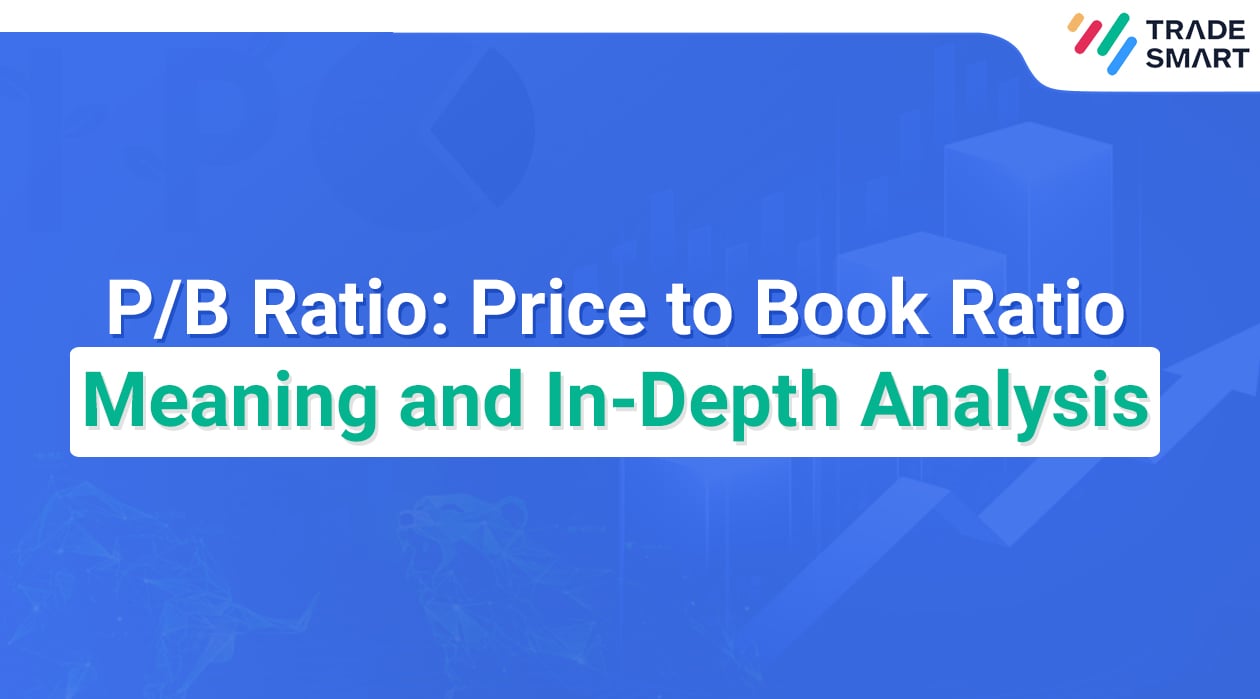The PE ratio basks in its glory of significant fame when investors dive into Share Market discussions.
If you are a market-savvy investor who wants to make intelligent investing decisions, you must already keep your tabs on the PE Ratio.
It is the most popular financial tool in the cohort of investors.
But why?
Why is the PE Ratio important?
The PE Ratio facilitates investing decisions by determining the relative value of a stock. It aids peer to peer comparison between the companies of the same industry and helps to point out whether a stock is overvalued or undervalued.
The PE Ratio is easy to calculate, and it helps investors gain an edge over calculating the expected future earnings of a company. The standardised ratio status makes it less time consuming and more informative for the investors.
To know the secrets behind this never-ending fame, we need to dive into the details of the PE Ratio.
So, what is the PE Ratio?
PE Ratio Meaning.
The Price to Earnings Ratio evaluates the Market Price per Share of a company considering its Earnings Per Share (EPS).
Earnings multiples and Price multiples are some synonyms for the Price to Earnings Ratio.
PE Ratio Formula
The formula for calculating the Price to Earnings Ratio divides the Share’s Current Market Price by Earnings per Share (EPS).
Price to Earnings Ratio = Market Price per Share / Earnings per Share
If there is a lack of clarity about the number of shares, then PE Ratio Formula is as follows:
Price to Earnings Ratio = Market Capitalisation of the company / Net Earnings.
Components of the Formula
Market Capitalisation is the total market share of the company.
Net Earnings of a company is the overall profit made by a company during a financial year.
Market Price per Share is the current stock price of the company’s share in the stock market. It is a value that represents the price that investors need to pay to purchase a particular company’s stock. One can easily find this value through market infographics.
Earnings per Share, however, is a little complicated. It is either calculated by looking into the company’s performance for the last 12 months or by waiting for the company to release their expected earnings.
The calculation of the PE Ratio through this 12-month performance is known as Trailing Price to Earnings. It is also popularly abbreviated as TTM in Wall Street Magazine, where TTM means trailing twelve months.
The company’s earnings release estimates the potential earning expectations of the company.
If the calculation of the PE Ratio executes from this figure, it is known as Forward Price to Earnings.
So, Forward Price to Earnings and Trailing Price to Earnings are two varieties of Earnings Per Share.
There is a third method of finding the PE Ratio by using the company’s average earnings over a while. This method is called the Shiller Price to Earnings.
Read on for a detailed description of these three methods.
Forward Price to Earnings.
Forward PE is a forward-looking method of calculating a company’s earnings, and it is also known as Leading PE or Estimated PE. This metric provides investors with some clarity into the future of the company.
Investors use this figure to compare the current earnings with the expected gains. This comparison tells you what the future looks like for a particular company.
However, one of the significant drawbacks of this methodology is the potential underestimation. A company can underestimate this figure to achieve a high PE during the announcement of upcoming quarter earnings. One can also overestimate this figure and adjust it similarly during the report of subsequent quarter earnings.
Sometimes, market experts provide their estimates about the future of a company. These estimates can turn out to be different from that of the company. This difference in opinion can cause chaos among the investors.
Trailing Price to Earnings.
This methodology is the most popular metric for calculating PE. In this method, the total Earnings Per Share (EPS) of the past 12 months facilitates the calculation of PE.
Trailing PE is more popular than Forward PE because some investors are sceptical about future estimates. They like to look at proofs rather than estimates.
A significant drawback of Trailing PE is that it demonstrates the past performance of a company rather than the future. But, Investors mostly shell out their money based on future expectations.
Another drawback could be that past earnings are constant, whereas market prices fluctuate. Hence, the trailing PE is highly volatile because any significant changes in the stock market reflect in the trailing PE.
Many investors prefer Forward PE because of the highly volatile nature of Trailing PE.
From the analysts’ point of view, if the Forward PE is less in value than the Trailing PE, the earnings are supposed to rise. And, if the Forward PE is more in value than the Trailing PE, the profits are supposed to fall.
Let us demonstrate the use of the PE Ratio with the help of an example.
Example of the PE Ratio.
To understand better, let us take an example of this MNC named Moodle. It is known that the stock price of Moodle for 5th March 2022 is INR 100.50 per share, and the Earnings per Share (EPS) for Moodle is INR 10.50.
We need to calculate the given company’s Price to Earnings Ratio for a specific period.
To get started with the calculations of the PE Ratio, we require just these two pieces of information, the company’s closing stock price per share and the company’s earnings per share.
As we know, the formula for the PE Ratio is as follows:
PE ratio = Market closing stock price per share/ Earnings per share
OR
Market capitalisation/ Total net earnings.
In this scenario, the stock price and EPS are on display. Hence, we need to use the former formula.
So, the P/E Ratio for Moodle as of 5th March 2021 will be as follows:
Moodle’s PE Ratio = INR 100.50 / INR 10.50 = 9.57
Interpretation
The current market value of Moodle is 9.57 times more than its net earnings of the year. If you buy all the shares of the company named Moodle, it will take you 9.5 years to earn back that amount through the profits made by this investment.
How to compare companies using the PE Ratio?
Let us take an additional example where we can look at two MNCs and compare their PE ratio to understand earning growth in the future relative to the market.
If Stock A is trading at $40 and Stock B is trading at $30, now determining P/E from a cheaper valuation perspective, P/E can be of much help.
Assuming that the FMCG sector’s average P/E is 20, stock M has a P/E of 20, and stock N has a P/E of 40. This result concludes that stock M is cheaper despite the higher absolute price because one has to pay less for every $1 of current earnings.
On the other side, Stock N has a higher P/E compared with its competitor and the sector, enabling investors to expect higher future earnings growth relative to the market.
What is an Ideal PE Ratio?
The most vital aspect for an investor while analysing their investment options using PE Ratio is the ideal range of the Ratio.
At the onset, we must clarify that the ideal PE Ratio varies from sector to sector, and it is also dependent on the market conditions and the industry-wise performance.
Therefore, while assessing the PE Ratio of a company, one should perform a peer to peer comparison to know how a specific industry is performing.
There is no specific value for the investors to rely on while analysing the PE Ratio of a company. A higher value of the PE Ratio can signal risky value trap investments. In comparison, a lower value might indicate fundamental faults in the company that might result in its sub-par performance.
To analyse their investment options successfully, one should use other indicators, like, cash flow at a discount, the weighted average cost of capital, etc., to ascertain the credibility of their investment choice.
ABSOLUTE P/E RATIO.
The absolute PE ratio is the classic method of calculating the PE Ratio. While calculating the Absolute PE Ratio, the Current Market Price per share is divided by EPS. Here, the EPS is either the trailing EPS or the forward EPS.
Sometimes, the EPS can also combine the trailing EPS of the last two quarters and the forward EPS of the following two quarters.
Therefore, the significant difference between the Absolute PE Ratio and the Relative PE Ratio is that the Absolute PE ratio considers earnings based on the current period.
RELATIVE P/E RATIO.
The Relative PE Ratio is a complex methodology that compares the latest Absolute PE Ratio with a range of past PE Ratios from a specific period, like the last decade.
This comparison tells an investor about the percentage increase or decrease in the current PE ratio concerning the past PE Ratios. The chosen base for comparison is the highest value from the range of past PE Ratios. But, sometimes, investors also select the lowest PE Ratio from the ridge to calculate the difference in the current PE ratio from the lowest range by far.
A PE ratio below a hundred per cent indicates that the current PE ratio is lower than what it has been in the past.
A PE Ratio above a hundred percent indicates that the current PE Ratio is higher than all the past PE Ratios.
How to evaluate stock by using the PE Ratio?
Stock Analysis and the PE ratio go hand in hand. It is impossible to analyse a company’s stock without looking at its PE Ratio. The PE Ratio is vital for estimating the value of a company, as it helps the investor understand whether a stock price is overestimated or underestimated. This Ratio is also beneficial for the sector to sector comparison and evaluation of past performances.
It helps the investor compare the market price with the company’s earnings. This comparison dictates what the market thinks about the company based on its past performance or future potential.
A higher PE ratio signals a higher market value than the actual earnings, indicating that the stock might be overvalued.
Conversely, a low PE Ratio indicates a lower market value than the actual earnings.
How to understand an investor through the PE Ratio?
We can find out what an investor is expecting from a stock company by analysing the PE Ratio of that company. A company with a high PE Ratio suggests that the investor expects the company to deliver increased earnings in the future. However, a low PE Ratio may indicate that the company is undervalued and is performing better than in its past performances.
What does it mean if the PE Ratio is Not Applicable (N/A)?
Sometimes, the PE ratio is given as N/A, which means not applicable. There can be various reasons behind this input.
The first and foremost reason can be a loss-making company or a company that has made no earnings this financial year. When a company incurs a loss or has made no profit in a financial year, the PE ratio is not provided for that company. One can calculate a negative PE Ratio in this case. But, N/A is the general trend.
The second reason for a N/A input for the PE Ratio can be a new company. A company that has recently been listed in the stock market or is a case of initial public offering (IPO) can have its PE Ratio as N/A. The N/A can also mean that the company has not made any earnings or it has not reported them yet.
The PE Ratio can also be used as a standard measurement to decide whether a stock is worth investing in or not.
Few financial decisions may affect the PE Ratio.
When a company takes certain financial decisions, they affect the PE Ratio of the company.
For example, when a company buys back its shares, it reduces the number of claims in the market, thereby increasing the earnings per share and decreasing the value of the PE Ratio.
However, when a company executes the right issues and dilutive FPOs, there is a rise in the number of shares, increasing the value of the PE Ratio.
Share prices also represent the market sentiment of a company, and it hints at the narrative and thought process of the company. This representation is subject to the sectors. Hence, it is crucial to consider an intra-sector comparison while analysing the PE ratio of a company.
Merits of the PE Ratio.
When investors want to evaluate a stock, the PE Ratio is their go-to tool. But, one must remember that it is not the only tool.
- A PE ratio can help an investor identify an overestimated or underestimated stock.
- It also helps an investor compare its performance with other companies in the same sector. It is mainly helpful in vast markets like the S & P 500 index.
- When an investor wants to look at the long-term past performance of the company, they can easily consider the Trailing PE of the last two-three decades of the company.
- A vital usage of the PE Ratio is to determine whether the figure of earnings stated by the company stands true in comparison with their market performance or not. It helps the investor in understanding the position of the company.
Demerits of PE Ratio.
The Price to Earnings Ratio is a good starting point but not the ultimate valuation measure and financial tool for investment decision analysis. However, it is a quick metric for the valuation of a company’s stock price.
But, there are certain limitations which are as follows:-
- Different industries can have varied PE Ratios, so it does not serve the purpose of investment decisions until it compares the same sectors with similar characteristics. But, it does not work well when used for comparing industries from varied sectors.
- Varying accounting methods may lead to misleading estimations while displaying the PE Ratio. Companies can report positive and higher earnings while having negative cash flow, which explains that they are spending more than they are earning. Still, a high PE Ratio can be deceptive of the actual financial situation of the company.
- The PE Ratio cannot be taken as a reliable method for investment decisions as stock prices fluctuate every day and a company’s earnings are released every quarter, leaving room for misinterpretation on the investor’s part.
ANALYSIS AND OTHER CONSIDERATIONS.
Analysing the PE ratio with an apple to apple comparison can better picture your investment choices.
Let us say you are evaluating the PE ratio of an automobile firm.
If the PE Ratio of that automobile firm is high, it can be a cause of concern because it might look like a risky value trap investment. But, if you look at the PE Ratio of other companies in the same sector and find a similar trend of high PE ratio among all those companies, you might feel relieved about your investment choices.
The accuracy of the PE ratio depends on the accuracy of inputs in the formula, and this mandate limits the PE Ratio. The current market price can be deemed accurate because it is estimated through an auction and is shared worldwide through various sources.
But, the company executes the calculation of earnings per share. Because the company is the single and only source of information, this input is taken with a pinch of salt.
The company has complete authority to manipulate its Earning Per Share, and this manipulation can help the firm gain investors’ and analysts’ trust. But, once a company breaks the trust of its investor, the value of the company falls in the market.
Companies might manipulate data to trap investors. But, expert investors say that one needs to change the values of all the other parameters accordingly if one wants to control the PE Ratio, and this is a nearly impossible task. Hence, the PE Ratio can be a reliable metric when considering the other financial tools.
The company’s debt also plays a significant role in the distortion of the PE Ratio Value, and a company’s obligation also affects the market price of its share. Debt can also affect a company’s earnings, which can bring higher gains because of good operations and risk rewards of the debt. However, a burdensome debt followed by a lousy business can be lethal for a company. A company with more debt tends to have a lower PE Ratio value than the one with less debt.
Conclusion
Overall, one can say that the PE Ratio is a vital tool for financial analysis. It aids investors in identifying overvalued and undervalued stocks, thereby helping them make better investment decisions.
But, it also has its shortcomings. The PE Ratio can be manipulated easily. This manipulation is why an investor should look at multiple financial tools to gain a holistic picture instead of focusing on just one statistic.





